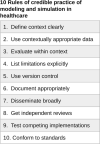Adapting modeling and simulation credibility standards to computational systems biology
- PMID: 37496031
- PMCID: PMC10369698
- DOI: 10.1186/s12967-023-04290-5
Adapting modeling and simulation credibility standards to computational systems biology
Abstract
Computational models are increasingly used in high-impact decision making in science, engineering, and medicine. The National Aeronautics and Space Administration (NASA) uses computational models to perform complex experiments that are otherwise prohibitively expensive or require a microgravity environment. Similarly, the Food and Drug Administration (FDA) and European Medicines Agency (EMA) have began accepting models and simulations as forms of evidence for pharmaceutical and medical device approval. It is crucial that computational models meet a standard of credibility when using them in high-stakes decision making. For this reason, institutes including NASA, the FDA, and the EMA have developed standards to promote and assess the credibility of computational models and simulations. However, due to the breadth of models these institutes assess, these credibility standards are mostly qualitative and avoid making specific recommendations. On the other hand, modeling and simulation in systems biology is a narrower domain and several standards are already in place. As systems biology models increase in complexity and influence, the development of a credibility assessment system is crucial. Here we review existing standards in systems biology, credibility standards in other science, engineering, and medical fields, and propose the development of a credibility standard for systems biology models.
© 2023. The Author(s).
Conflict of interest statement
The authors declare that they have no competing interests.
Figures
Similar articles
-
Modeling and simulation credibility assessments of whole-body finite element computational models for use in NASA extravehicular activity applications.Comput Methods Biomech Biomed Engin. 2025 Mar;28(4):450-463. doi: 10.1080/10255842.2023.2293653. Epub 2023 Dec 21. Comput Methods Biomech Biomed Engin. 2025. PMID: 38130093
-
Computational models in systems biology: standards, dissemination, and best practices.Curr Opin Biotechnol. 2022 Jun;75:102702. doi: 10.1016/j.copbio.2022.102702. Epub 2022 Feb 23. Curr Opin Biotechnol. 2022. PMID: 35217296 Free PMC article. Review.
-
Modeling and Simulation Tools: From Systems Biology to Systems Medicine.Methods Mol Biol. 2016;1386:441-63. doi: 10.1007/978-1-4939-3283-2_19. Methods Mol Biol. 2016. PMID: 26677194 Review.
-
Computational Systems Biology of Morphogenesis.Methods Mol Biol. 2022;2399:343-365. doi: 10.1007/978-1-0716-1831-8_14. Methods Mol Biol. 2022. PMID: 35604563
-
Computational systems biology and dose-response modeling in relation to new directions in toxicity testing.J Toxicol Environ Health B Crit Rev. 2010 Feb;13(2-4):253-76. doi: 10.1080/10937404.2010.483943. J Toxicol Environ Health B Crit Rev. 2010. PMID: 20574901
Cited by
-
Multi-scale models of whole cells: progress and challenges.Front Cell Dev Biol. 2023 Nov 7;11:1260507. doi: 10.3389/fcell.2023.1260507. eCollection 2023. Front Cell Dev Biol. 2023. PMID: 38020904 Free PMC article. Review.
-
A rubric for assessing conformance to the Ten Rules for credible practice of modeling and simulation in healthcare.PLoS One. 2025 Jun 25;20(6):e0313711. doi: 10.1371/journal.pone.0313711. eCollection 2025. PLoS One. 2025. PMID: 40560895 Free PMC article.
-
From FAIR to CURE: Guidelines for Computational Models of Biological Systems.ArXiv [Preprint]. 2025 Feb 21:arXiv:2502.15597v1. ArXiv. 2025. PMID: 40034129 Free PMC article. Preprint.
-
Computational modelling of cardiovascular pathophysiology to risk stratify commercial spaceflight.Nat Rev Cardiol. 2024 Oct;21(10):667-681. doi: 10.1038/s41569-024-01047-5. Epub 2024 Jul 19. Nat Rev Cardiol. 2024. PMID: 39030270 Review.
-
Making PBPK models more reproducible in practice.Brief Bioinform. 2024 Sep 23;25(6):bbae569. doi: 10.1093/bib/bbae569. Brief Bioinform. 2024. PMID: 39494970 Free PMC article.
References
-
- Assessing the credibility of computational modeling and simulation in medical device submissions: Draft guidance for industry and food and drug administration staff. U.S. Food and Drug Administration, 2021.
Publication types
MeSH terms
Grants and funding
LinkOut - more resources
Full Text Sources
Research Materials



